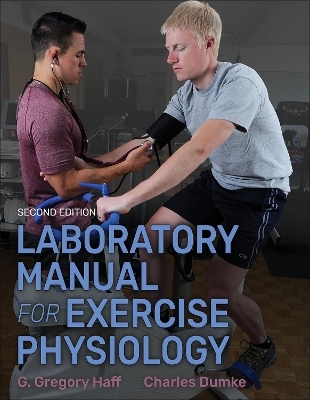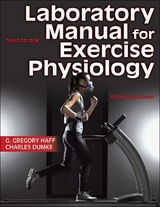
Laboratory Manual for Exercise Physiology
Human Kinetics (Verlag)
978-1-4925-6343-3 (ISBN)
This is the loose-leaf version of Laboratory Manual for Exercise Physiology, Second Edition With HKPropel Access, which offers students a lower-priced printed version of the text. Other binding options are also available.
Laboratory Manual for Exercise Physiology, Second Edition With HKPropel Access, provides guided opportunities for students to translate their scientific understanding of exercise physiology into practical applications in a variety of settings. Written by experts G. Gregory Haff and Charles Dumke, the text builds upon the success of the first edition with full-color images and the addition of several new online interactive lab activities .
The revitalized second edition comprises 16 laboratory chapters that offer a total of 49 lab activities. Each laboratory chapter provides a complete lesson, including objectives, definitions of key terms, and background information that sets the stage for learning. Each lab activity supplies step-by-step procedures, providing guidance for those new to lab settings so that they may complete the procedures. New features and updates in this edition include the following:
Related online learning tools delivered through HKPropel that contain 10 interactive lab activities with video to enhance student learning and simulate the experience of performing the labs in the real world
A completely new laboratory chapter on high-intensity fitness training that includes several popular intermittent fitness tests that students can learn to perform and interpret
An appendix that helps estimate the oxygen cost of walking, running, and cycling
New research and information pertaining to each laboratory topic
A lab activity finder that makes it easy to locate specific tests
In addition to the interactive lab activities, which are assignable and trackable by instructors, HKPropel also offers students electronic versions of individual and group data sheets of standards and norms, question sets to help students better understand laboratory concepts, and case studies with answers to further facilitate real-world application. Chapter quizzes (assessments) that are automatically graded may also be assigned by instructors to test comprehension of critical concepts.
Organized in a logical progression, the text builds upon the knowledge students acquire as they advance. Furthermore, the text provides multiple lab activities and includes an equipment list at the beginning of each activity, allowing instructors flexibility in choosing the lab activities that will best work in their facility.
Laboratory Manual for Exercise Physiology, Second Edition With HKPropel Access, exposes students to a broad expanse of tests that are typically performed in an exercise physiology lab and that can be applied to a variety of professional settings. As such, the text serves as a high-quality resource for basic laboratory testing procedures used in assessing human performance, health, and wellness.
Note: A code for accessing HKPropel is included with all new print books.
G. Gregory Haff, PhD, CSCS,*D, FNSCA, is an associate professor and the course coordinator for the postgraduate degree in strength and conditioning at Edith Cowan University in Joondalup, Australia. Haff has published more than 80 articles, centering his research on performance effects in the areas of strength training, cycling, and nutritional supplementation. Haff is the president of the National Strength and Conditioning Association (NSCA) and a senior associate editor for the Journal of Strength and Conditioning Research. He was the United Kingdom Strength and Conditioning Association (UKSCA) Strength and Conditioning Coach of the Year for Education and Research and the 2011 NSCA William J. Kraemer Outstanding Sport Scientist Award winner. He is a certified strength and conditioning specialist with distinction, a UKSCA-accredited strength and conditioning coach (ASCC), and an accredited Australian Strength and Conditioning Association level 2 strength and conditioning coach. Additionally, Haff is a national-level weightlifting coach in the United States and Australia. He serves as a consultant for numerous sporting bodies, including teams in the Australian Football League, Australian Rugby Union, Australian Basketball Association, and National Football League. Charles Dumke, PhD, is a full professor in the department of health and human performance at the University of Montana, where he teaches undergraduate and graduate courses. He has taught courses in exercise physiology for over 15 years, first at Appalachian State University and then at the University of Montana. He earned his doctoral degree in kinesiology from the University of Wisconsin at Madison. His areas of interest in exercise science are energy expenditure, fuel utilization, economy of movement, mechanisms of mitochondrial adaptation, and diabetes. He has published more than 100 peer-reviewed articles on these topics. Dumke is a fellow of the ACSM and serves on several national and regional committees. In his free time, Dumke enjoys competing in triathlons, biking, running, taking on building projects with little know-how, and coaching his son in ball sports. He resides in Missoula, Montana, with his wife, Shannon; son, Carter; and dog, Rastro.
Laboratory 1. Primary Data Collection
Test Variables
Measurement Terminology
Metric Conversions
Background and Environmental Information
Descriptive Statistics
Presentation of Results
Interpretation of Data
Laboratory Activity 1.1: Basic Data
Laboratory Activity 1.2: Statistical Procedures
Laboratory Activity 1.3: Tables and Graphs
Laboratory 2. Pretest Screening
Informed Consent
Physical Activity Readiness Questionnaire for Everyone
Health History Questionnaire
Signs and Symptoms of Disease and Medical Clearance
Coronary Risk Factor Analysis
Lifestyle Evaluation
Disease Risk Stratification
Laboratory Activity 2.1: Basic Screening Procedures
Laboratory Activity 2.2: Pretest Results
Laboratory 3. Flexibility Testing
Direct and Indirect ROM Assessment
Body Areas
Laboratory Activity 3.1: Traditional, Wall, V-Sit, and Chair Sit-and-Reach Test Comparisons
Laboratory Activity 3.2: YMCA, Backsaver, and Goniometer Test Comparisons
Laboratory Activity 3.3: Canadian, Traditional, and Backsaver Sit-and-Reach Test Comparisons
Laboratory Activity 3.4: Shoulder Flexibility Test Comparisons
Laboratory 4. Blood Pressure Measurements
Blood Pressure Responses to Exercise
Accurate Blood Pressure Checks
Laboratory Activity 4.1: Effects of Body Position on BP
Laboratory Activity 4.2: Effects of Dynamic Exercise on BP
Laboratory Activity 4.3: Effects of Isometric Contractions on BP
Laboratory 5. Resting Metabolic Rate Determinations
Aerobic Metabolism and Respiratory Exchange Ratio
Total Energy Expenditure and RMR
Laboratory Activity 5.1: Predicting RMR
Laboratory Activity 5.2: Measuring RMR
Laboratory 6. Oxygen Deficit and EPOC Evaluations
Transition From Rest to Exercise
Oxygen Uptake During Exercise and Recovery
Laboratory Activity 6.1: Calculation of Oxygen Deficit and EPOC
Laboratory 7. Submaximal Exercise Testing
Measurement of Heart Rate
Rating of Perceived Exertion
Laboratory Activity 7.1: Submaximal Bench Step Test
Laboratory Activity 7.2: Submaximal Treadmill Test
Laboratory Activity 7.3: Submaximal Cycle Ergometer Test
Laboratory 8. Aerobic Power Field Assessments
Cooper 1.5-Mile Run/Walk Test
Cooper 12-Minute Run/Walk Test
Rockport Fitness Walking Test
Laboratory Activity 8.1: Cooper 1.5-Mile Run/Walk Test and 12-Minute Run/Walk Test
Laboratory Activity 8.2: Rockport Fitness Walking Test
Laboratory 9. High-Intensity Fitness Testing
Léger 20 m Shuttle Run Test
Yo-Yo Intermittent Recovery Test
30-15 Intermittent Fitness Test
Laboratory Activity 9.1: Léger 20 m Shuttle Run Test (20mSRT)
Laboratory Activity 9.2: Yo-Yo Intermittent Recovery Test (Yo-Yo IRT)
Laboratory Activity 9.3: 30-15 Intermittent Fitness Test (30-15IFT-40m)
Laboratory Activity 9.4: Modified 30-15 Intermittent Fitness Test (30-15IFT-28m)
Laboratory 10. Maximal Oxygen Consumption Measurements
Selecting a Test Protocol
Monitoring Progress With RPE Scales
Estimating Fuel Usage With RER
Ventilatory Threshold
Laboratory Activity 10.1: Graded Treadmill V̇O2max Test
Laboratory Activity 10.2: Cycle Ergometer V̇O2max Test
Laboratory 11. Blood Lactate Threshold Assessment
Determining the Deflection Point
Selecting a Test Method
Role of the Ventilatory Threshold
Laboratory Activity 11.1: Blood Lactate Measurement at Rest
Laboratory Activity 11.2: LT During an Incremental Cycle Test
Laboratory Activity 11.3: Blood Lactate After Anaerobic Exercise
Laboratory 12. Musculoskeletal Fitness Measurements
Assessments of Muscular Strength
Assessments of Muscular Endurance
Laboratory Activity 12.1: Maximal Upper-Body Strength
Laboratory Activity 12.2: Maximal Lower-Body Strength
Laboratory Activity 12.3: Maximal Handgrip Strength
Laboratory Activity 12.4: Upper-Body Muscular Endurance
Laboratory 13. Anaerobic Fitness Measurements
Sprinting Performance Tests for Estimating Horizontal Power
Jumping Performance Tests for Determining Vertical Power
Formulas for Estimating Vertical Power
Bosco Test for Estimating Power Endurance
Determining the Eccentric Utilization Ratio
Wingate Anaerobic Test for Determining Anaerobic Cycling Power
Margaria-Kalamen Stair-Climb Test for Determining Anaerobic Power
Laboratory Activity 13.1: Sprinting Performance
Laboratory Activity 13.2: Jumping Performance
Laboratory Activity 13.3: Jumping Performance With a Switch Mat
Laboratory Activity 13.4: Power Endurance
Laboratory Activity 13.5: Anaerobic Cycling Power
Laboratory Activity 13.6: Margaria-Kalamen Stair-Climb Test
Laboratory 14. Pulmonary Function Testing
Pulmonary Function Testing
Pulmonary Function Testing as a Tool for Diagnosing Pulmonary Disease
Respiratory Limitations on Exercise
Laboratory Activity 14.1: Lung Volumes and Capacities
Laboratory Activity 14.2: Pulmonary Function
Laboratory Activity 14.3: Exercise-Induced Ventilatory Limitations
Laboratory Activity 14.4: Exercise-Induced Asthma
Laboratory 15. Body Composition Assessments
Body Composition Models
BMI for Categorizing Body Composition
Circumference Measurements and Health Risk
Skinfold Thickness as a Measure of Body Fat
Laboratory Activity 15.1: BMI and Circumference Data
Laboratory Activity 15.2: Techniques for Measuring Skinfold Thickness
Laboratory Activity 15.3: Estimating Relative Body Fat Using Hydrodensitometry
Laboratory 16. Electrocardiograph Measurements
Electrical Activity of the Heart
Placement of ECG Leads
Interpreting the ECG Recording
ECG as a Tool for Diagnosing Cardiac Abnormalities
HR Response to Exercise
Laboratory Activity 16.1: Resting ECG
Laboratory Activity 16.2: Effects of Body Position on the Heart Axis
Laboratory Activity 16.3: Submaximal Exercise Effects With the 12-Lead ECG
Appendix A: Units of Measure Conversions
Appendix B: Estimation of the O2 Cost of Walking, Running, and Leg Ergometry
Appendix C: Haldane Transformation
Appendix D: Metabolic Cart Information
Appendix E: Calibration of Equipment
Appendix F: Certifications in Exercise Science
| Erscheinungsdatum | 03.06.2021 |
|---|---|
| Verlagsort | Champaign, IL |
| Sprache | englisch |
| Gewicht | 1270 g |
| Themenwelt | Studium ► 1. Studienabschnitt (Vorklinik) ► Physiologie |
| ISBN-10 | 1-4925-6343-9 / 1492563439 |
| ISBN-13 | 978-1-4925-6343-3 / 9781492563433 |
| Zustand | Neuware |
| Haben Sie eine Frage zum Produkt? |
